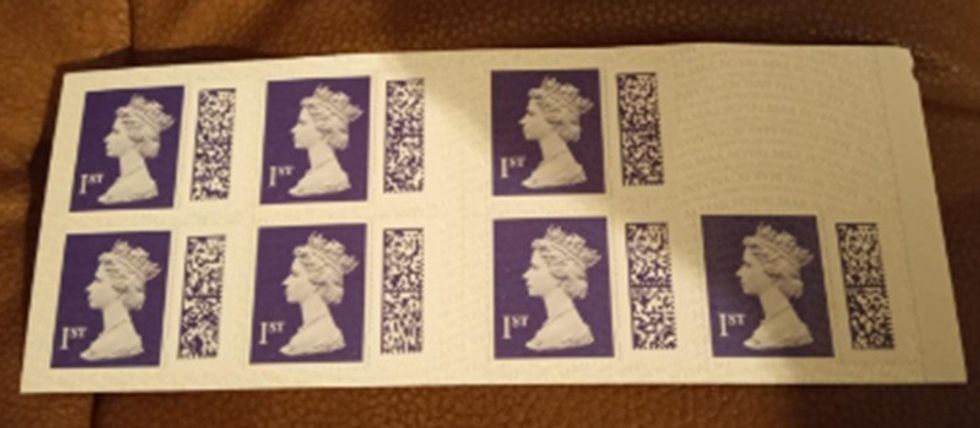GB News is urging Royal Mail to investigate its systems after our investigation found some stamps are being deemed “counterfeit” by Royal Mail, while other stamps from the same book are not.
Royal Mail yesterday told ministers it would investigate problems with new barcoded stamps to try and “ascertain the source of the problem” amid fears customers are wrongly being fined to get letters.
Lorraine Hewitt declined to pay the £5 fee, missing out on her birthday card containing £5
GB NEWS | LORRAINE HEWITT
The sender says they bought the book of stamps from a well-known supermarket.
Ms Hewitt, from the West Midlands, had assumed she had been sent a parcel when she found a £5 “fee to pay” note from Royal Mail in her letterbox.
She had received all the birthday cards she had anticipated she may get, and, ahead of a birthday dinner with her brother that evening, she took the note to the delivery office.
She said: “I thought, ‘Oh as he’s coming tonight, if he’s got a card, he’ll bring it with him.’
“Because he was taking me out for a meal, I assumed that that was my birthday gift as it were.”
The member of staff showed her the envelope but, not recognising the writing, she decided not to pay the fee.
However, before she left the delivery office, she took a photo of the envelope, which had a yellow sticker branding the stamp “counterfeit” attached.
During the birthday outing, it emerged the card had been from her brother, and it contained a £5 note.
Having bought the book of eight stamps from a reputable supermarket, he decided to send a test letter using another of the stamps.
It arrived without a hitch.
Ms Hewitt’s brother has also since sent his niece some mail using another stamp from the book. Again, the letter arrived as expected.
“It makes you question what criteria they are actually using to determine if something is fraudulent,” the 66-year-old told GB News.
Ms Hewitt, who used to work in Royal Mail’s Returned Letters Branch (RLB), believes because the letter contained cash, it would need to be logged.
“You have to make a note of the item and make a note of the money and store the money or the goods that would be in there,” she said.
Ms Hewitt complained to Royal Mail about the matter and has sent photos of the book of stamps as well as the “counterfeit” label.
She was told that “specialised machines at all our mail centres examined stamps to check if they are genuine or not”.
The email continued: “If a stamp or stamps are deemed not genuine a surcharge is applied and the recipient is asked to pay the fee.
“This gives the recipient the opportunity to receive the item as quickly as possible.”
Ms Hewitt escalated the complaint to the Postal Review Panel, who requested she sent the envelope which was surcharged or the stamps being called counterfeit to their Freepost address.
However, Ms Hewitt pointed out she does not have the envelope, as it’s with Royal Mail.
She was later told that while they “appreciate” she forwarded photos of the item and stamps, they “cannot identify if a stamp is counterfeit or not with photographs”.
Ms Hewitt said: “They’ve got the item, they’ve got the stamp, they’ve actually got the fiver.
“All they need to do is find this item in the Returned Letters Branch, find what they’ve done with the fiver, and have a look whether someone’s made a human error with regard to deciding if the stamp was counterfeit, as the other stamps have proved not to be.”
LATEST DEVELOPMENTS:

Lorraine Hewitt was told the stamp her brother used was “counterfeit” but others from the same book have not been deemed “counterfeit”
LORRAINE HEWITT
After GB News contacted Royal Mail, the Postal Review Panel contacted Ms Hewitt, who told her they had arranged for Royal Mail to forward a £5 cheque to replace the £5 note in the card, which was located at the National Returns Centre.
A Royal Mail spokesperson said: “From the images we have received all of the stamps in the book are scanning as counterfeit. The stamp on the envelope is also scanning as counterfeit.
“There is no postmark cancellation on the test letter sent by the customer who purchased the stamps. This would indicate it was processed manually and our machines did not therefore identify it as counterfeit.
“The process for manual processing relies upon human intervention to identify a counterfeit stamp and on this occasion it was not picked up by our people – this is due in part to the high quality of some counterfeits in circulation.
“Any items sent to the National Returns Centre(NRC) that are found to contain cash are logged and retained for one month awaiting a claim from the customer.
“Following your enquiry we contacted the NRC and the £5 was located. We will be reaching out to the customer to arrange for it to be returned.”
A Royal Mail spokesperson said: “Royal Mail takes the illegal production of counterfeit stamps seriously. Since the introduction of barcoded stamps we have been able to significantly reduce stamp fraud through added security features.
“Every barcode is unique which allows us to identify whether a stamp is genuine or not, and whether they have been previously used.
“We want our customers to buy stamps with confidence. We strongly recommend that customers only purchase stamps from Post Offices and other reputable High Street retailers, and not to buy stamps online – unless from the official Royal Mail shop.
“Our website provides customers with guidance on how to spot counterfeit or used stamps and we urge customers to report any suspicious stamps to Royal Mail via our website at www.royalmail.com/report-stamp-fraud so that we can investigate.
“We are working hard to remove counterfeit stamps from circulation. We regularly monitor to detect suspicious activity, such as sales of heavily discounted stamps and work closely with retailers and law enforcement agencies to identify those who produce counterfeit stamps.
“We have a robust, multistage process in place when assessing whether stamps are genuine. This includes a thorough examination using specialist equipment, then a follow-up inspection by a skilled member of the team before any stamp is marked as counterfeit or pre-used.”
Source link


